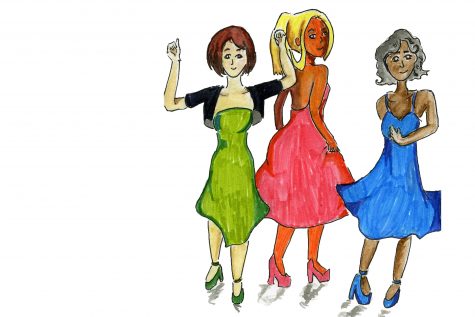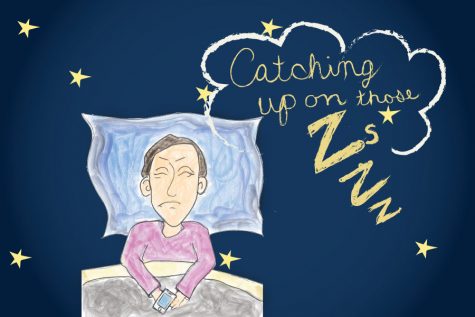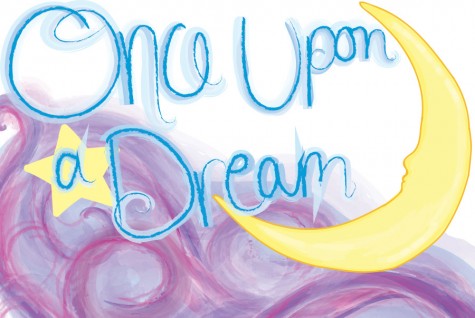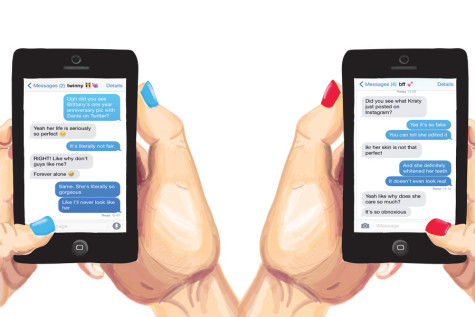The Patriot In-Depth: Uncovering how phobias infiltrate lives of students and faculty
As junior Kaley Martin walks happily through the mall, she suddenly freezes. Her hands start shaking and she begins to hyperventilate as she nears the booth that sells remote control helicopters. Still unable to move, she starts to get dizzy as her fear increases.
Martin has a phobia of remote control helicopters, severe enough to make her stop in her tracks whenever she sees them.
“My brothers would always fly them around my head, and I was convinced that [a] helicopter would get caught in my hair or rip my head off,” Martin said.
In addition to this fear, Martin also has a phobia of gorillas and climbing ladders. “I am afraid of gorillas because they are big, strong, and scary, and also because you never know what they are thinking,” Martin said. “I’m afraid of climbing ladders because ladders are dangerous. I am convinced that if I climb a ladder, it will collapse, and I will fall to my death.”
Senior Leanne Ches has been claustrophobic for as long as she can remember.
“I basically get extremely anxious whenever I am in a confined area. The best way to describe it is feeling trapped, which causes me to become really stressed and panicked. My phobia also has to do with rooms without windows because that also triggers the same fears and feelings as being in a confined area does,” she said.
When Ches was eight years old, she had a panic attack when she got trapped in an elevator.
“I got super anxious. I ended up crying until we got out,” Ches said.
Ches believes that this event might have triggered her phobia of closed spaces, however she is not completely sure.
Phobias and their Symptoms
Phobias are anxiety disorders, which cause above average physiological arousal, worry, concern, and fear. The main differences between fears and phobias are that phobias are more intense, affect one’s life in a negative way, and interfere with one’s functioning.
Social Studies teacher and Psychologist Paul Lazor describes a phobia as an “irrational fear.”
“The most common phobias are snakes and spiders, public speaking, and heights,” Lazor said.
A student survey sent out to the school asked students questions about their greatest fears and phobias. It was found that 47.7 percent of students claim to have some level of great fear towards spiders. 30.5 percent of students said they have a fear of heights, and 25.5 percent said they have a fear of public speaking.
The survey found spiders to be the number one fear among students, followed by heights. The third worst fear among JC students was a fear of rejection. A fear of public speaking followed in fourth.
Public speaking is still a common phobia. One person who responded to the survey said, “I can’t talk in front of a class without almost passing out.”
“One time I had to speak in front of the class, I didn’t cry or anything, but my hands shook and I sweated a lot,” another said.
As far as heights, one student said, “I was on a Ferris wheel and usually I can be up that high, but something happened and I started to have a panic attack so bad they had to stop the ride.”
Freshman Sean Campbell is also afraid of heights.
“Going on like rollercoasters, the first part I don’t really like, the initial drop. You’re going really fast, and I just feel like whenever I’m in a high place that I’m going to fall,” Campbell said.
Also, many students responded to the survey giving stories about their phobia of needles, even though it was not one of the common phobias mentioned.
“I fainted in the middle of the floor at Wendy’s after getting my tetanus shot, because my vision blacked out and I felt so nauseous,” one student said.
Another student with a fear of needles said, “One time I had to go to the nurse’s office because we were talking about needles, and I was getting dizzy. I blacked out in the hallway and had to be wheel-chaired there.”
A fear of rejection was also not on the list of what Lazor thought to be common phobias, but it does affect students at JC. One person said they couldn’t even ask people out on dates any more for fear of being turned down.
Another student responded and said, “I am also afraid of rejection. It’s hard for me to talk to people. If I’m at a store and see something I want, but it’s not my size or something, the thought of asking an employee for help terrifies me as well. I’d rather not get the thing I’m looking for than ask someone, because I’m afraid of their reaction to my question.”
According to guidance counselor Larry Hensley, social phobias are one of the most common phobias he deals with. He has also dealt with phobias of flying and germs.
Common phobias are not all people will find at JC.
Sophomore Megan Mueller has a phobia of fish.
“I can’t go into aquariums, because I don’t like fish. They are just creepy,” Mueller said.
Smaller fish don’t always bother her. She actually has one goldfish at home.
“It’s not the goldfish necessarily, but the big angler fish or the bigger fish that scare me,” she said.
Phobias have many different symptoms, including nervousness, anxiety, shaking of hands or body, difficulty breathing, crying, panic attacks, sweating, and racing heart rates. These are the most common symptoms among JC students according to the student survey, but there are many more.
“I have panic attacks, and they are incredibly scary. I wish them upon no one. Fear is something I have to deal with rather often,” one student said.
Causes of Phobias
According to WebMD, “about 11 percent of people have had a phobia at some time,” but the causes of phobias are unknown. Some theories do exist as to why people have these irrational fears, such as that of learned response.
“If someone at a young age has an experience with something that causes [an] intense amount of anxiety, they then could bring that into their older years,” Lazor said. “If this situation causes them a large amount of worry or anxiety, they will generalize this to the situation.”
In a survey response, one student responded talking about how they developed Claustrophobia, the fear of being trapped in small, confined spaces.
“I did not have Claustrophobia until I had to be in an MRI for a serious neck injury. I was in the MRI for two hours because I kept getting anxiety and freaking out. Ever since, when I feel stuck or trapped, I get really bad anxiety,” the student said.
Another person interviewed, but who wishes to remain anonymous developed their phobia of elevators at the age of five or six during a family trip. He would rather take flights of stairs than have to go on an elevator.
“My parents, when I was like five or six, took us to Disney World, and they told us the Tower of Terror was our hotel. When we went in, there were all these people, and as a little kid, I realized it was a bit strange, especially with the seat belts. I asked my parents, and they just said that was because it was a ‘very rich, very fancy hotel. There are a lot of people that go here,’“ he said.
The Tower of Terror, though, is not a hotel, but a thrilling attraction in Hollywood Studios that propels people up 199 feet and then drops them down only to catch them and send them up again to be dropped over and over.
“When the ride started up, it acted like a normal elevator, and then it dropped,” he said, “I was screaming for about four hours. I thought I was going to die. I’m surprised my lungs didn’t give out.”
This student credits his phobia of elevators to this experience in his childhood. Since then, he has thought more on it and does not think he will change his view anytime soon.
“When you think about the concepts behind elevators, how it’s a box suspended by strings, probably very strong strings, it doesn’t make you feel so confident in the system either, especially when there is a weight capacity limit,” he said.
Another explanation as to why people tend to be afraid of certain objects, such as snakes and spiders, is because it has been wired into our DNA. However, this has not been proven true, and studies are ongoing.
“Maybe our ancestors thousands of years ago were afraid of snakes and spiders, and those people that were afraid of them were able to fight them, lived and passed down the genes of the offspring, and then it is embedded into our genetic background,” Lazor said.
For some, an element in the environment causes a strong natural response with anxiety and fear. Then, they will avoid all other related objects or situations.
“People who have phobias generally try to avoid the things that make them anxious,” Lazor said.
This theory proves true for Martin. “I try to avoid having to climb ladders if at all possible, and I stay as far away as I can from the remote control helicopter stand in the mall,” Martin said.
Dealing with phobias can be easier said than done. Many phobias, such as fear of spiders and snakes, can be avoided easily by not spending much time outside. Others, however, are hard to avoid, such as the fear of walking or bathing.
Freshman Holly Driver has a phobia of stink bugs that has proven difficult for her to avoid.
“When I see a stinkbug, I get really shaky and my breathing speeds up until I am breathing very fast,” Driver said.
“My fear started as they began to appear around my house a few years ago. It became really bad until I had a dream that one was flying at me, and then I woke up to a stink bug flying at me,” she said.
Driver, with the support of her family, has taken active steps to avoid the stink bugs.
“My family tries to get me to pick them up, but that does not work. I am paranoid that there will be stink bugs in my room at night, and I have cried because they have landed on me,” Driver said. “I just try to avoid them at all costs. For example, I would never go into the port-a-potties at my cross country meets because there was once a stink bug in one.”
French teacher Regina Ferry has difficulty completely avoiding her phobia. She has a fear of wide open spaces with nothing in them.
“I had an anxiety attack in La Camargue in the South of France in like a flat, barren, plain space, but I never would have known that I would be afraid of it had I not experienced it. I actually calmed down when we came to a sand dune because I said ‘oh look, there is something,’” Ferry said.
Dealing with Phobias
Phobias have the potential to take over people’s lives.
“My fear has kept me away from experiencing new things. It has completely changed me from what I was before,” one student said in reply to the survey.
Another student said, “There are times I refuse to sleep, because I am so scared of failing in a class or the dark. I would stay up all night, because my heart was unable to slow down and my muscles would not relax. Once I went 64 hours without sleep, I was so upset.”
In the survey, a student explained how they dreamed of becoming a glaciologist, but their biggest fear was “to freeze to death and that no one will find me.”
Some people with phobias try to find ways of coping, so that their phobias do no completely ruin their lives.
“If you want to overcome a phobia, you have to confront what makes you anxious. The treatment for phobias is some sort of exposure to the phobic object,” Lazor said.
There are two different types of therapy: systematic desensitization and flooding. In systematic desensitization, the person takes the course step-by-step, from learning to relax, then building up to pictures and videos of the object of situation and eventually leading up to encountering the fear in person.
Flooding involves putting people into the situation or with an object that they dread and making them find a way to overcome the fear while in a room with it.
The only way to free oneself from a phobia is by exposing oneself. With the right help, one should eliminate the fear.
For students, a phobia can reach a point where their school work is being affected.
“I have a fear of failure, so in common instances, instead of trying to do something, I’ll give up on whatever I am doing so that I can’t fail. This sometimes affects my writing, personal projects, homework, etc.,” one student said in response to the survey.
Any JC student or faculty member with an uncontrolled fear should talk to a trusted adult. In doing so, they prevent the phobia from overwhelming their life.
Meredith Haggerty, Hope Kelly, and Lauren Fabiszak are In-Depth Editors for The Patriot and jcpatriot.com.














